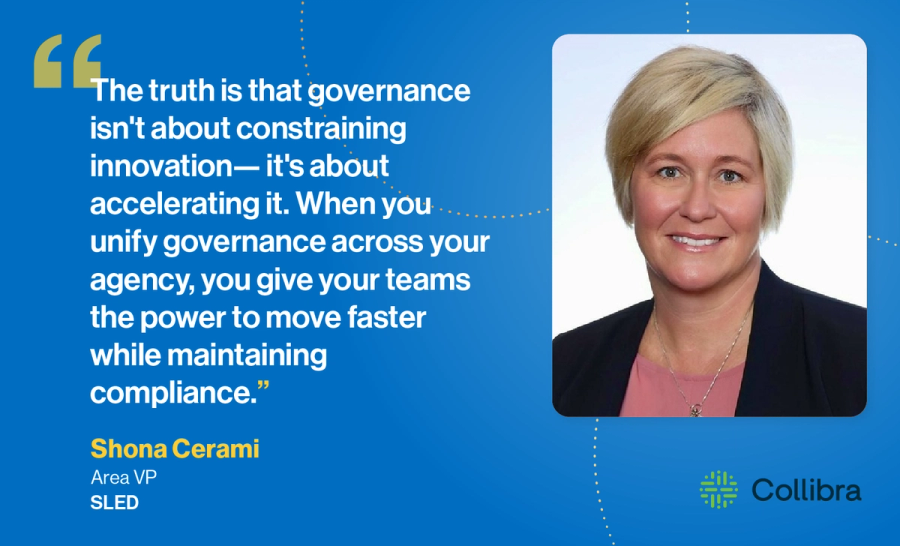The power of Student 360: See how unified governance drives more graduates

Picture this: your campus is bustling with students full of potential, yet too many aren't making it to graduation day.
It's a scenario that keeps university presidents and boards up at night, and for good reason. Student success is the lifeblood of your institution's reputation, financial health and mission.
It doesn’t have to be this way. Why? Because most colleges are swimming in data and have numbers on everything from meal swipes to midterm scores. But turning that jumble of information into something that actually helps students? Too often, schools operate in a landscape peppered with data silos. And this is where things typically fall apart.
It’s also where Collibra can help. We don’t add another system to your tech stack. We make sense of what you already have by creating a single view of all the data across your organization—so it can be governed in a unified way. Think of us as the connective tissue that turns scattered student information into a powerful tool for keeping learners on track from day one all the way to graduation.
Discover the Collibra Platform. Take a tour
Student 360: The way forward for success
When we talk about optimizing data for colleges and universities, we call it Student 360.
Student 360 provides a complete view of each student's journey—from that first campus tour to alumni giving.
The magic happens when a residence hall coordinator notices a student hasn't been using their meal plan, an advisor sees their attendance dropping, and a financial aid counselor spots a missed payment. In each of these scenarios, the dots are connected in real time, instead of after the student has packed their bags.
Let’s look a little close at why your data is so fragmented.
Why your campus data is stuck in silos
The modern campus operates as a constellation of specialized systems, each collecting valuable student data yet functioning in isolation.
- Your CRM meticulously tracks prospective student interactions
- Your SIS manages enrollment data
- Your LMS captures learning engagement patterns
- Financial aid systems monitor student economic health
All of this is in operation without meaningful integration. And it creates blind spots precisely where holistic student understanding is most critical. When an academic advisor can't see that a student's declining performance correlates with recent financial hardship, the opportunity for timely, coordinated intervention vanishes.
Perhaps more insidious than system isolation is inconsistency across institutional domains about basic data management best practices.
How many students are enrolled?
The seemingly straightforward question "How many students are enrolled?" produces dramatically different answers depending on who you ask. Registrars count students who’ve scheduled classes, financial aid includes only those who've completed verification, while institutional research applies yet another standard for federal reporting. These competing definitions fundamentally undermine strategic decision-making by creating parallel, often contradictory understandings of institutional reality.
Data lineage—the ability to trace information to its source and understand its transformations—represents another critical vulnerability. Without clear lineage tracking, institutions struggle to verify data accuracy, validate analytical conclusions or demonstrate regulatory compliance. This opacity becomes particularly problematic during accreditation reviews, when questions about graduation rate calculations or student outcome metrics demand transparent, defensible answers rather than black-box statistics.
The most immediate operational pain point remains accessibility—getting the right information to the right people at the right time. Faculty members identifying concerning patterns, advisors conducting intervention meetings, and support staff managing care teams frequently find themselves navigating byzantine access barriers when time-sensitive decisions matter most.
This friction directly impacts student outcomes when intervention windows close before relevant information reaches decision-makers.
Collibra: Transforming fragmented governance into confidence
In your institution's data-saturated landscape, the path to meaningful student support is all about connecting what you already have.
The Collibra Platform transforms fragmented data ecosystems into a unified governance solution that drives measurable student success outcomes without replacing existing systems.
Reshaping student success
Our approach addresses fragmentation through four interconnected capabilities that create a foundation for data-driven student support.
- Establishing data governance
- Creating intuitive data discovery capabilities
- Providing comprehensive data lineage solutions
- Enabling powerful workflows
Data governance: Collibra creates a shared framework where definitions, ownership and accountability become institutional assets rather than departmental liabilities.
Data discovery: Transform how campus teams find and leverage student information. Empower student-facing staff to access comprehensive profiles without navigating multiple logins or interfaces.
Data lineage: Establish crucial context for institutional decision-making by tracking information provenance across its lifecycle. This transparency creates confidence during high-stakes reporting periods while enabling sophisticated impact analysis for student success initiatives.
Workflows: Establish collaboration architectures that align teams while maintaining appropriate access controls. These structured workflows ensure that student concerns identified in one domain automatically trigger appropriate responses across the support ecosystem, transforming traditional siloed approaches into coordinated networks.
The collective impact of these capabilities extends beyond operational efficiency to fundamentally upgrade how institutions understand and support student journeys. By creating visibility across traditional boundaries while maintaining appropriate privacy protections, Collibra can help your institution drive proactive student support, rather than reactive crisis management.
Following the money: Students aren’t one-size-fits-all
Understanding student financial profiles is a strategic imperative that shapes both institutional sustainability and student outcomes. But student financial profiles create fundamentally different institutional dynamics.
- In-state and out-of-state students represent dramatically different revenue models. This variance shapes everything from recruitment strategies to accessibility initiatives.
- The scholarship and grant landscape adds another layer of complexity. Today's financial aid ecosystem blends institutional funds, federal programs, state initiatives and private philanthropy, each with distinct compliance requirements and performance expectations.
- Need-based aid recipients, particularly Pell-eligible students, present unique support requirements extending beyond finances into academic and social domains.
- Enrollment intensity further diversifies financial impact, as part-time learners follow fundamentally different revenue trajectories compared to full-time students.
Understanding these patterns enables more sophisticated forecasting that can align your institutional offerings with actual enrollment behaviors.
Real impact: What success looks like with Student 360
When institutions implement a comprehensive Student 360 approach, transformation happens across multiple dimensions simultaneously.
All of the following scenarios are within reach for your institution:
- Academic advisors transition from reactive problem-solvers to proactive success coaches, identifying at-risk students weeks earlier than traditional systems and deploying targeted interventions while small challenges are still manageable.
- Institutional leaders gain newfound confidence in their data, ending the eternal debate about whose numbers are "right" and shifting those conversations toward strategic action based on trusted insights everyone can rally behind.
The ripple effects extend throughout the entire institution, creating virtuous cycles of improvement.
- Students experience seamless support as service providers access comprehensive profiles tailored to their unique circumstances, eliminating the frustration of repeating their story across multiple offices.
- Institutional advancement leverages clean historical data to nurture alumni relationships based on authentic student experiences rather than generic appeals
- Finance teams develop sophisticated cohort analysis that reveals how different student populations contribute to long-term sustainability—information that shapes everything from recruitment strategy to program development.
How to start your Student 360 journey
Just imagine what your institution can gain with unified governance. And getting started with Student 360 doesn't require a massive institutional overhaul. Start with strategic focus and the right partnerships.
You can get started today. Discover the Collibra Platform.
Try this: Begin by selecting one high-visibility challenge where unified data can demonstrate immediate impact.
Tip:
Most institutions find that retention initiatives or academic advising enhancements provide the perfect launchpad, creating visible wins that build momentum for broader adoption.
Success requires bringing the right voices to the table from day one. Form a cross-functional team that includes institutional research for analytical expertise, IT for technical implementation, academic affairs for curricular context and student support services for frontline perspectives.
The magic happens when these traditionally siloed teams collaborate around student-centered outcomes rather than departmental metrics. Leverage your existing technology investments by connecting Collibra with platforms already embedded in your ecosystem.
Most importantly, recognize that lasting transformation requires cultural change and building an environment where data is treated as a strategic asset rather than an administrative burden.
Ready for Student 360?
Explore the Collibra Platform. Take a tour today
Related articles

AIJuly 15, 2024
How to observe data quality for better, more reliable AI

AIJune 12, 2024
Understanding the OMB Memorandum and AI Governance

Public SectorJanuary 31, 2025
From fragmentation to confidence: A strategic guide to the 2025 state regulatory landscape

Data QualityDecember 20, 2022
Smarter, cleaner, faster: AWS + Collibra help government make better decisions
Keep up with the latest from Collibra
I would like to get updates about the latest Collibra content, events and more.
Thanks for signing up
You'll begin receiving educational materials and invitations to network with our community soon.
